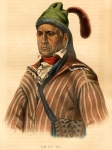
In the years before the Creek War (1813-1814) the Creek Confederacy’s towns (talwa) stood along rivers and creeks in east-central Alabama and southwestern Georgia. Divided into three districts, its people called themselves Muscogee. When the white man arrived, the white man called them Creeks for the many rivers and streams on which they lived. To further distinguish them geographically, settlers and traders referred to them as Upper and Lower Creeks.
CREEK DISTRICTS
Georgia: Lower Creeks
Ochese (Coweta): Chattahoochee River Basin and Flint River
Alabama: Upper Creeks
- Tallapoosa: lower Tallapoosa River
- Abeika: Upper Tallapoosa and Coosa Rivers
The Town
A Creek village consisted of summer and winter houses built around a rectangular field, like a plaza. Below are photos of reconstructed examples of both a winter and a summer Creek house, which I took during a visit to the Fort Toulouse-Fort Jackson Park in Wetumpka, Alabama. Wetumpka is the Creek word for “tumbling water”, named for a waterfall on the Coosa River.

This is a Creek winter house built on upright poles, its walls plastered with mud and its roof thatched. These roofs also had a hole in them for smoke to pass through.
This is a Creek summer house.

During the winter, councils met in a thatched round building called a rotunda. In warm seasons, they held councils beneath arbors.
These village also had a game field for playing chunkey, a game I described in a previous post.
Red Towns/White Towns
Before their homeland was colonized, the Creeks separated their towns into red and white. In the red towns, they held war ceremonies and in the white towns, peace ceremonies.
William Bartram’s Diagram
William Bartram (1739-1823) was a famous botanist who explored Alabama, recording his observations in a journal. He gave us a diagram of a Creek village, which I show below.

A. The rotunda
B. The town square
C. The chunkey field
Surrounding structures–Creek houses
Sources
“The Muscogee Creek—1600-1840,” National Park Service, Last updated May 24,2021. The Muscogee Creek – 1600 – 1840 – Little River Canyon National Preserve (U.S. National Park Service) (nps.gov).
Hahn, Stephen C. “Creeks in Alabama,” Encyclopedia of Alabama, March 8, 2007, Last updated February 22, 2024, Creeks in Alabama – Encyclopedia of Alabama.
“History,” Fort Toulouse-Fort Jackson, Friends of the Fort Foundation, Last Accessed March 14, 2024. History | Fort Toulouse – Fort Jackson | Wetumpka, AL (fttoulousejackson.org).
Lewis, J.D. “The Native Americans, Creek Indians,” Carolina, 2007. Carolina – The Native Americans – The Creek Indians (carolana.com).


